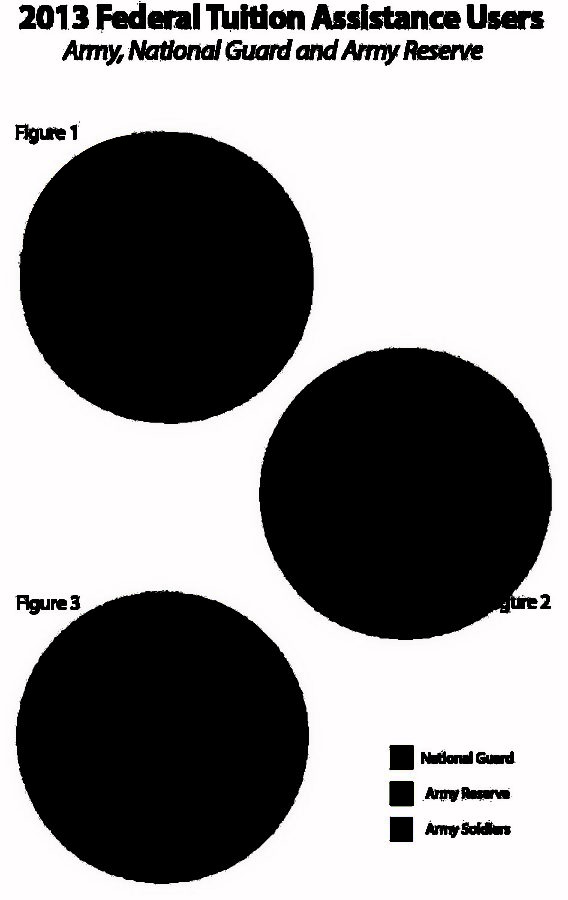Federal tuition assistance changes affect active-duty military students
Melissa Kroksh, Robert Mercer/Iowa State Daily
Figure 1 shows last year’s numbers of soldiers who were using tuition assistance with less than one year of service.Figure 2 shows the numbers of soldiers who took more than 16 credit hours last year using tuition assistance.Figure 3 shows the numbers of soldiers pursuing graduate studies, using tuition assistance, with less than 10 years of service.
February 4, 2014
Recent changes to the federal tuition assistance program could mean big changes for students enlisted in the Army, National Guard or Army Reserves.
A program that was originally set out to provide soldiers with a part-time, off-duty way to continue their education, the tuition assistance program has recently added some new policies to better ensure the original intent is being met.
“They looked at the program and said, ‘If an active duty soldier is taking more than 16 credits per year, then they probably aren’t spending as much time at their full-time job of being in the Army [as] they should,’” said Major Ron Sykora of the Iowa National Guard.
On Jan. 1, the federal tuition assistance program officially added new policies that are affecting active duty members pursuing a higher education.
Before a student can receive school funding, one of the new policy changes to the federal tuition assistance program now requires students to be enlisted for a full year after completing initial entry training.
“Before [the changes], a student could enlist and immediately get the benefits,” Sykora said. “The problem with that is if somebody enlists, goes to school and then fails the training, then the government spent a lot of money to pay for their schooling, and that person never gave any service back to the government.”
Initially, the program had no limit on how many credits a soldier could take per year, as long as it was under $4,500. One of the new policies has also changed that.
Federal tuition assistance will now only cover 16 semester hours per fiscal year, only if the soldier meets the army’s requirements of passing the physical fitness test, meeting the weight requirement and having no adverse action flags.
“They limited it to 16 [credit hours] to ensure that soldiers are doing the job they are supposed to be doing, [while] still providing assistance to the service member,” Sykora said.
The third major change is for military members who pursue a graduate degree.
If a soldier uses the federal tuition assistance program to complete their bachelor’s degree, then they must be enlisted for 10 years before they can use tuition assistance to achieve a graduate degree.
This policy change does not affect active duty students who did not use federal tuition assistance to attain their bachelor’s degree, but they still must be enlisted for a full year to have funding approved.
But there are factors that contribute to who is affected by the changes.
For example, if an active-duty student had their paperwork filed by Dec. 31, they would still be accepted into the program without the new policies.
“We at Iowa State did our best to help soldiers get their paperwork in on time so that they wouldn’t be affected by those policy changes,” said Jathan Chicoine, Iowa State’s veteran’s services coordinator.
While the federal tuition assistance program has always had various stipulations for students, such as the funding cannot be used to pursue a professional degree, the new policy changes have affected some student’s decisions to enlist.
Iowa State student Blair Mirka, freshman in biology, said she was always interested in the National Guard and saw getting tuition assistance as an added bonus — but then decided not to enlist after learning of the policy changes.
“Knowing I wasn’t going to get the assistance took off some of the urgency to make the decision [to enlist] in my freshman year,” Mirka said. “Now I can wait and think about it more and maybe enlist when I graduate.”
However, for those interested in enlisting now, there are alternate funding options for active-duty members.
“Anybody who joined the military, that maybe joined for educational benefits, are now potentially in a position where they don’t have access to federal tuition assistance,” Chicoin said. “But that doesn’t mean there aren’t other options.”
Other funding options include the G.I. Bill for veterans, various military scholarships, ROTC scholarships, financial aid and payment plans offered through the university.







